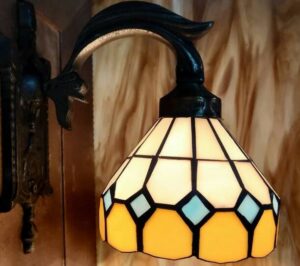The history of antique lamps is a fascinating journey through time, reflecting the evolution of human ingenuity and craftsmanship. From the ancient oil lamps of clay and bronze to the ornate Victorian gas lamps, the materials used to make these lighting fixtures have transformed significantly.
In early civilizations, simple pottery and metal lamps were used as functional items, often adorned with symbols of cultural significance. As societies progressed, more elaborate materials such as brass, bronze, and glass emerged, reflecting the artistic movements of their respective eras.
For instance, the opulent Art Nouveau period saw the rise of Tiffany lamps, with their intricate stained glass designs. Simultaneously, the Industrial Revolution introduced wrought iron and other durable metals into mainstream lamp production.
By exploring these materials and their historical context, we gain valuable insights into the cultural fabric that shaped the creation of antique lamps.
Materials Used to Make Antique Lamps
Antique lamps were crafted using a range of materials, some of which are still in use today. Here are the most commonly used materials:
Metal
Metal is the most popular material used to make antique lamps. Metal lamps are valued for their durability, versatility, and intricate designs. The primary metals used for antique lamps include copper, bronze, and brass.
Copper lamps are highly valued for their patina, which is the greenish-blue color that develops over time. Copper can also be polished to achieve a shiny finish. Bronze and brass lamps are valued for their ornate designs, durability, and resistance to corrosion. They can be polished to achieve a high shine, but a natural patina can develop over time, which is often desirable for collectors.
Glass
Glass is another popular material for antique lampshades or bases. Artisans can manipulate glass into a variety of shapes, transparency levels, and colors. Stained and leaded glass lamps are highly desirable for collectors due to their intricate designs. Cut glass lamps are also popular due to the detailed patterns that can be etched into the surface.
However, glass can be fragile and prone to breaking. Antique lamps with glass components require extra care when cleaning and handling.
Porcelain
Porcelain is a type of ceramic, often used for lamp bases. Porcelain lamps have a delicate and refined look and are often decorated with colorful painted designs. Porcelain lamps are highly valued for their artistic quality and intricate designs.
However, porcelain is fragile and can be easily damaged when dropped or mishandled. Scratches or chips can greatly reduce the value of a porcelain lamp.
Crystal
Crystal lamps are highly valued for their beauty and brilliance. Many crystal lamps are made by renowned crystal manufacturers and are highly sought after by collectors. Waterford Crystal and Baccarat are two of the most famous crystal manufacturers of antique lamps.
Crystal lamps can have intricate patterns and facets within the glass that catch and reflect light. However, crystal can be fragile and delicate, requiring special handling and care to avoid breaking or damage.
Bronze and Brass
Bronze and brass lamps are highly valued for their ornate designs and durability. They often include elaborate detailing, embossed designs, and raised features. Both metals can be polished to a high shine but may also develop a natural patina over time.
Bronze and brass lamps are less prone to corrosion and rust, adding to their durability and value. Examples of bronze and brass lamps include Art Nouveau lamps and Tiffany-style lamps.
Marble
Marble is a luxurious material used for antique lamp bases. It is prized for its durability, attractive natural patterns, and smooth surface. Marble lamps come in a variety of colors and patterns, making each lamp unique.
However, marble is heavy and fragile, and can crack or chip if dropped or mishandled. Additionally, because of its weight and cost, marble lamps can be rare and costly.
Wood
Wooden lamps have a classic, natural look and are often used for lamp bases. They come in a variety of finishes, such as oak and mahogany, and can be carved into intricate designs. Wooden lamps are valued for their natural beauty, warm colors, and elegant designs.
However, wood can chip, scratch, and be susceptible to insect damage. Wooden lamps require careful handling and care to avoid damaging the delicate finishes.
Antique Lamp Restoration
Antique lamp restoration requires careful consideration of the materials used in the lamp. Different materials require different restoration methods, and improper cleaning or restoration can greatly reduce the value of the lamp.
- For example, metal lamps can be polished using a metal cleaner and a soft cloth, while glass lamps should be cleaned with a glass cleaner and a soft cloth. Porcelain lamps should be handled with care, as they can be easily scratched or chipped if mishandled.
- For crystal lamps, it is recommended to use a mild soap solution, a soft cloth, and delicate handling.
- For bronze and brass lamps, it is important to use a non-abrasive, metal cleaner and a soft brush to remove any oxidation.
- Marble lamps should be cleaned with gentle soap and a soft cloth, avoiding any harsh chemicals that could damage the surface.
- Wooden lamps should be polished with a furniture polish and a soft cloth, taking care not to saturate the wood with too much moisture.
Restoration should always be performed by a professional, particularly for materials like glass and porcelain that require meticulous care and handling. Amateur or improper restoration can severely damage the lamp’s value and condition.
Conclusion
Antique lamps are valued for not only their beauty but also for the materials used to create them. Understanding the characteristics and values of different materials can help collectors and enthusiasts appreciate the craftsmanship and history of each lamp.
By taking care to properly handle and restore antique lamps, their value and beauty can be preserved for future generations to enjoy.

